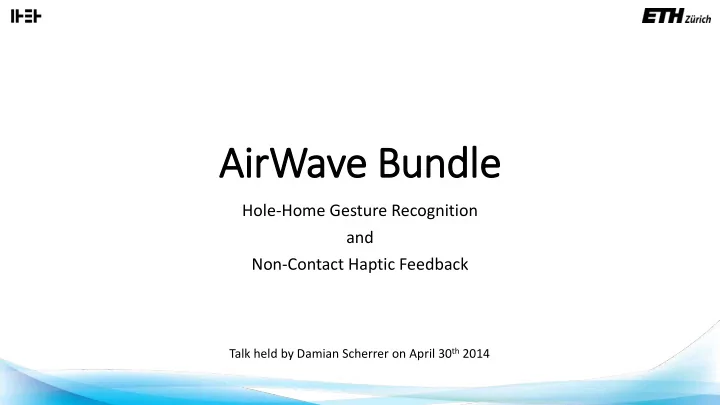

AirWave Bundle Hole-Home Gesture Recognition and Non-Contact Haptic Feedback Talk held by Damian Scherrer on April 30 th 2014
New Means of Communicating with Electronic Devices Input Whole-home gestures (WiSee) Response Non-contact haptic feedback
Known Examples for Gesture Recognition
Known Examples for Haptic Feedback • In general: Establish a two-way physical communication between an electronic device and it‘s user
An Approach using EM Signals & Air Vortex Rings Gesture recognition and haptic feedback without instrument- alisation of the body A new way to communicate with electronic devices?
WiSee, a New Approach for through-the-wall Gesture Recognition • Signal source can be a standard IEEE 802.11 a/g/n transmitter • Transmitted signals are reflected by humans that are in range • If the person is moving the signal is Doppler-shifted • Reflected signals are received by receivers of the same standard Q: Which frequency-band (2.4Ghz or 5GHz) should be used?
Doppler-Shifts Contain Information of Motion • Doppler-Shifts are proportional to the speed of human motion: • Assuming human motion directly towards the receiver at 0.5m/s • This leaves us with a Doppler-shift of nearly 17Hz • (5GHz WiFi-band: Channels of 20MHz, divided into 64 sub-channels of 312.5kHz bandwidth each and 250k symbols/s) It seems we have a problem here!
Narrowing Down Sub-Channel Bandwidth • Assumptions: • OFDM (Orthogonal Frequency Division Multiplexing) Channel • Same symbol is sent over considered timespan • Transmitter is sending constantly • Taking a large FFT over M consecutive symbols reduces the bandwidth of each sub-channel by a factor of M
Extracting Doppler-Shifts • Sliding window of 0.5 s results in a resolution of about 2Hz • Perform FFT every 5 ms
Mapping Shift-Patterns to Gestures
Support Multiple Humans using MIMO 1 • Objectives: • Lock onto one user among other humans • Differentiate between users • Method: • Use personal preamble gestures • Maximise Doppler energy for an individual D: Doppler energy m: Preamble segment N: #Antennas W: Complex Weight
Support Multiple Humans using MIMO 2 • Looking at it from a physical perspective: Beam-forming
Addressing Multipath Q: How should the problem of multipath be addressed?
Practical Results
Quick Summary on WiSee • Using a standard WiFi setup • Human movements create Doppler-shifts • Detect Doppler-shifts after narrowing down sub-channel bandwidth • Map discrete frequency-shift-pattern to predefined gestures • Identify multiple users using complex MIMO weights
Formation of Vortex Rings • Fixed volume of gas (slug) is pushed out of an aperture • Low pressure region is formed around periphery region of aperture • Vorticity increases until reaching the critical mass
Air Vortex Rings Optimised for Haptic Feedback 1 • Stability of vortex defined as follows (formation number): • Previous research has shown that an L/D ratio between 1 and 4 forms a stable vortex • Vortex propagation speed equals half the slug speed Find parameters that maximise pressure applied by a vortex
Air Vortex Rings Optimised for Haptic Feedback 2
Found Parameters Proved to be Useful 1 • Vortex rings are shot at targeted person at a distance of 2.5m • 8 body locations, 10 test subjects • Subjects not instructed concerning clothing
Found Parameters Proved to be Useful 2 • Experiment Setup: • Experiment Results:
Summary and Possible Applications • WiSee: Proof of concept (link) • Possible Applications: • Use air vortex rings for applications with non-obvious feedback • Have gestures recognised when under the shower • …invent your own
References • Whole-Home Gesture Recognition Using Wireless Signals • Qifan Pu, Sidhant Gupta, Shyamnath Gollakota and Shwetak Patel • MobiCom 2013. • AirWave: Non-Contact Haptic Feedback Using Air Vortex Rings • Sidhant Gupta, Dan Morris, Shwetak Patel, Desney Tan • UbiComp 2013
Q & A
Recommend
More recommend